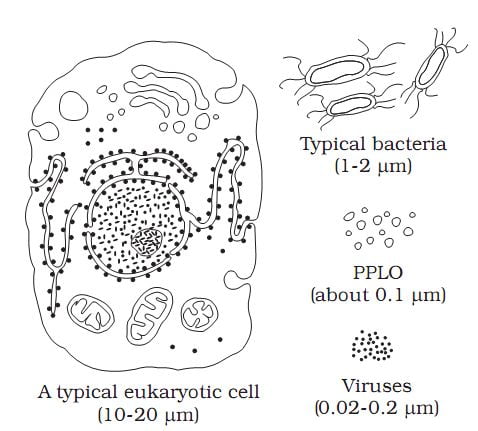Cell The Unit of Life MCQ Biology Class 11 / Objective question Chapter 8
1. Who gave cell theory?
- a. Schleiden and Schwann.
- b. Rudolf Virchow.
- c. Watson and crick.
- d. Leeuwenhoek
2. Cell theory explains that:
- a. Every organism consist of small units ‘cell’.
- b. New cells form from pre-existing cells.
- c. Cells are independent of each other.
- d. None.
3. _ _ _ _ _ told first that new cells arise from pre-existing cells (“Omnis cellula-e cellula).
- a. Schleiden and Schwann.
- b. Rudolf Virchow.
- c. Watson and crick.
- d. Leeuwenhoek
4. The largest isolated single cell is that of:
- a. Cyanobacteria.
- b. An amoeba.
- c. An egg of an ostrich.
- d. A human nerve cell.
5. Which organism among these does not have a cell wall.
- a. Bacteria.
- b. Fungus.
- c. Plant.
- d. Animals.
6. Which among these is the smallest in size?
- a. A eukaryotic cell.
- b. A typical bacterial cell.
- c. A pleuro pneumonia-like cell.
- d. A viral cell.

7. Ribosome of prokaryotic cells are:
- a. the 60s and 40s.
- b. the 70s and 3os.
- c. 50s and 30s.
- d. None.
8. Ribosome of eukaryotic cells are:
- a. the 60s and 40s.
- b. the 70s and 3os.
- c. 50s and 30s.
- d. None.
9. In the prokaryotic cell, the nucleus is
- a. Primitive type.
- b. Complex.
- c. Double membraned.
- d. None.
10. Which of the following is not a eukaryote?
- a. Protists.
- b. Plants.
- c. Animals.
- d. Cyanobacteria.
11. Unlike plant cells, animal cells have a centriole and a _ _ _ _ vacuole and
- a. Small.
- b. Large.
- c. No vacuole.
- d. None.
12. Which of the following do not have cell walls in their cells?
- a. Bacterium.
- b. Plant.
- c. Fungi.
- d. Animals.
13. Membrane-bound organelle is absent in:
- a. Prokaryotes.
- b. Plant cells.
- c. Animal cells.
- d. All three.
14. Cell membrane in the animal cell comprises of:
- a. Protein bilayer.
- b. Phospholipid bilayer.
- c. Phospholipid trilayer.
- d. None.
15. Lipid and neutral molecules can move in and out of an animal cell through:
- a. Passive diffusion.
- b. Osmosis.
- c. Active transport.
- d. Co-transport.
16. A cell wall is a _ _ _ _ structure.
- a. Semipermeable.
- b. Selectively permeable.
- c. Impermeable.
- d. None.
17. Which of the following is not a part of the endomembrane system?
- a. Chloroplast, Mitochondria, peroxisomes.
- b. Golgi bodies.
- c. Ribosome, SER.
- d. RER.
18. WHich of the following is the major site for lipid synthesis?
- a. Smooth endoplasmic reticulum.
- b. Rough endoplasmic reticulum.
- c. Golgi body.
- d. Peroxisome.
1. a. Schleiden and Schwann. 2. a. Every organism consist of small units ‘cell’. 3. b. Rudolf Virchow. 4. c. An egg of an ostrich. 5. d. Animals. 6. d. A viral cell. 7. c. 50s and 30s. 8. a. the 60s and 40s. 9. a. Primitive type. 10. d. Cyanobacteria. 11. a. Small. 12. d. Animals. 13. a. Prokaryotes. 14. b. Phospholipid bilayer. 15. a. Passive diffusion.16.a. Semipermeable. 17. a. Chloroplast, Mitochondria, peroxisomes. 18. a. Smooth endoplasmic reticulum. 19. d. All. 20. c. Blood. 21. Adipose tissue. 22. c. Blood. 23. a. Skeletal. 24. d. Hip. 25. Smooth. 26. c. Gap junctions as intercalated discs.
Next:
- The Living world MCQ Biology Questions
- Biological Classification MCQ Questions with answers
- Plant Kingdom MCQ Biology Class Eleven
- Animal Kingdom MCQ Biology
- Morphology of Flowering Plants MCQ
- Anatomy of Flowering Plants MCQ Biology
- Structural Organisation in Animals MCQ
Cell The Unit of Life MCQ Biology Class 11 / Objective question Chapter 8
*****
Ref: Chapter 7, NCERT.
Only pls check the no. 16…the ans given will match if cell membrane is written instead of cell wall